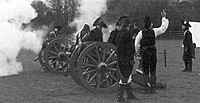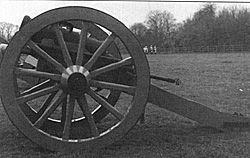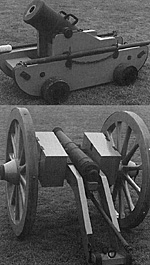Cannons in the Mist
Re-enactment
by Steve Vickers
| |
Two full size one pound Rostaings, a four pounder, a six inch howitzer and a sledge-mounted howitzer, brand new trails, some yet to be fired in battle . . . new toys for big boys.
The Corps d'artilleries were having their training weekend, along with invited friends from other Napoleonic units who cannot resist the lure of artillery.
Right from the start the esprit de corps was prevalent and all twenty-six re enactors were working together with one clear objective ... to work the guns safely and to good effect.
This had been a dream of the officers for many years. Already this year we have seen a battery of full size guns spanning the battlefield, manned by the distinctive all blue uniform of the French artilleryman. When the opportunity arises they join with sister companies from Germany, The Netherlands and the Czech Republic. With over 14 pieces of ordnance and well over 60 men this will be some sight!
Apart from the artillery regiments, there is the Genie under the command of Mike Crawshaw, responsible for pyrotechnics and new to the Corps, men who will ride with the horse artillery going through the paces of working with the guns.
In support of the troops there is a well organised team of 'femmes du troupe' including two cantinieres, a blanchisseuse and a coururiere, all of whom have specific duties within the corps and are all re-enacting women in their own right.
The first day consisted of setting crews for the guns and organising the campsite which consisted of officers' marquees, A-frames and cantineres' tents.
A film crew was present requiring footage of the guns being fired, so this was incorporated with the training drill and firing.
Consistent and methodical drill soon had the crew members firing confidently. Stopping only for a lunch break, the cantinieres making sure hot water for tea and coffee was always available.
On Sunday 'Appelle' was at 7.30 am and everyone was lined up in fatigue kit for the day's instructions.
The officers mapped out the day and the troops were instructed to clean and strip muskets before breakfast . The Dragoon Artillery were invited to use the facilities and joined in with battery firing. Also, the longest running Napoleonic Association re-enactment regiment, the Hoch und Deutschmeister, who sometimes accompany the Corps to overseas events where Austrians are not represented, worked with a gun themselves as they had done in Malta.
In the afternoon Mike Crawshaw gave a demonstration of pyrotechnics. Pyrotechnics will be used on most battle sites, especially around the cannon. Being familiar with all aspects of the Corps is essential for each part of the group to work cohesively and safely.
After the evening meal everyone retired to the bar ... and stayed until asked politely to leave. Needless to say, 'appelle' was slightly later the following morning! The final day was spent doing manoeuvres with the guns. Taking the artillery "walkies" gives a good idea of just how hard it would be to man handle guns over rough ground.
In summary, everyone had a great time. All the hard work Paul Elliott had put into building the new guns showed through and the team spirit was clear for all to see.
With more seasoned re-enactors joining, the corps is growing into a real battery of French bicentennial artillery, coming into its own when joining friends in Europe, all under Steve Vickers' command, all working to one objective.
This was most evident in Malta when all the artillery, including the British and Austrian, shared the Citadel at Gozo and worked together without any culture or personality clashes.
A true Corps needs artillery, infantry and cavalry. The artillery side is now looking very strong. The cavalry will be taking the field as Artillerie a Cheval in full dress, pelisse, dolman and colpack. With the infantry we are looking for individuals to boost this side of the corps.
If you are interested in becoming part of this exciting new military formation please contact the following officers.
Artillery - Paul Elliott 0116 291 6296
|
 Five cannon stood in a row, sentinels to a sleeping campsite. An early morning mist hung across the field giving the guns an atmosphere of having just been fired, but they were silent.
Five cannon stood in a row, sentinels to a sleeping campsite. An early morning mist hung across the field giving the guns an atmosphere of having just been fired, but they were silent.
 Six inch howitzer. An unusual example that's lighter and more maneuverable than foot artillery and almost exclusively used by horse artilley. Original in Musee de l'Armee, Paris, France.
Six inch howitzer. An unusual example that's lighter and more maneuverable than foot artillery and almost exclusively used by horse artilley. Original in Musee de l'Armee, Paris, France.
 Six in mountain slegde--an example of one variation used in Italian and Tyrol campaigns. At bottom: 1lb Rostaing. Originally designed by Gribeauval for regimental use, this later example was redesigned by a French officer whose name it now bears. It was the nearest the French artillery got to a galloper gun, as it was drawn by a single horse and capable of being dismantled very quickly.
Six in mountain slegde--an example of one variation used in Italian and Tyrol campaigns. At bottom: 1lb Rostaing. Originally designed by Gribeauval for regimental use, this later example was redesigned by a French officer whose name it now bears. It was the nearest the French artillery got to a galloper gun, as it was drawn by a single horse and capable of being dismantled very quickly.